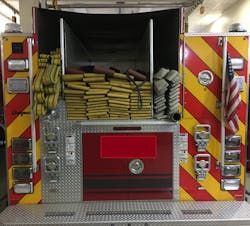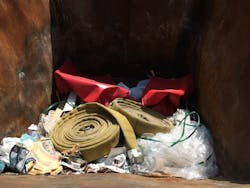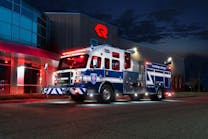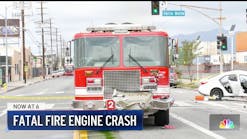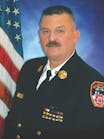Hosebed covers have been mandated in NFPA 1901: Standard for Automotive Fire Apparatus since November of 2005, but they were in use prior to that. The FDNY had them on its pumpers, and departments that operated in wildf ire areas utilized hard covers to protect hose from debris and embers. The NFPA mandate was created for entirely different reasons.
On Aug. 19, 2004, the Coraopolis, PA, Volunteer Fire Department was dispatched to a reported fire at approximately 2:30 p.m. While en route, after making a turn, a preconnected crosslay fell off of the right side of the engine, and the nozzle got lodged under the tire of a parked car. It stretched like the proverbial rubber band and then snapped free. The nozzle sailed past Coraopolis resident Sophie Spencer, knocking over her birdbath and mowing down two hibiscus plants. Joyce Schmidt was outside with her 10-year-old daughter, Erin, and Erin’s friend, Joeylynne Jeffress. Both girls were struck by the nozzle on the right side of the face. They were airlifted to Children’s Hospital of Pittsburgh. Jeffress underwent two surgeries within 48 hours of the accident. Erin Schmidt died at the hospital the next day.
This incident prompted the NFPA to add some type of hose-restraint mandate to NFPA 1901. Unfortunately, it isn’t the only loose-hose incident that resulted in the injury or death of a civilian.
Not uncommon
When researching these incidents, the most common phrase to describe them that’s found in media reports is “freak accident.” The word “bizarre” pops up periodically, and so does “rare.” The fact is loose-hose incidents are much more common than anyone who is in the fire service would like to acknowledge.
An 82-year-old woman was killed in Massachusetts and a 59-year-old man was killed in Ohio from injuries that were inflicted by loose fire hose that was being dragged by responding apparatus. In Tennessee, large-diameter hose that came off of the back of a truck wrapped around the axle of a moving passenger car. This caused the driver of the car to lose control of the vehicle and to hit a telephone pole. Extrication of the driver was required. In California, a crosslay that dropped off of an engine landed on the hood of a car. The impact of the crosslay damaged the windshield, and a child who was inside of the car was injured. In Florida and Minnesota, large-diameter hose falling off of apparatus caused multiple vehicle accidents.
There also are many cases of hose coming off of apparatus (both responding to alarms and returning to quarters) in which there only was property damage: good that nobody was hurt, bad because of the insurance claims that were filed against the departments.
There are loose-hose reports from virtually every FEMA zone in the country. Most of these didn’t involve injuries or property damage, but each incident could have caused one or both. The point is that these are not freak accidents, bizarre or rare: They happen often, and they shouldn’t be taken lightly.
Advances = accidents
When I started to research the particulars of incidents of hose coming off of apparatus, I noticed that incidents seemed to be happening more later in my career than earlier. I started a hunt for why and came up with the following.
Efforts to improve fire hose meant very different materials being used. Woven cotton outer jackets on hoses were replaced with woven synthetics: polyester, nylon, rayon or a synthetic blend. The weave of the synthetic outer jackets isn’t as coarse as their woven cotton counterparts. The synthetic materials are lighter, so the drag coefficient and the weight of the hose are reduced.
Also, the rubber sleeve that formed the inner liner in the hose was replaced with synthetics, including polyurethane, and brass couplings and brass nozzles were replaced with aluminum alloys. Single-jacketed rubber hose became the standard for large-diameter hose. Lighter weight and a smooth exterior jacket both contribute to fairly easy play-out once the process is started.
However, the very changes that made hose more user-friendly also contribute to accidental deployment issues, particularly when wind is a factor. When you think about it, what kept firehose in the hosebed without a cover? Gravity. It became apparent when the NFPA looked into the accidental deployment following the Pennsylvania incident that something to increase hose security needed to be done, and with each additional incident, the need was reinforced.
The Coraopolis Fire Department did nothing wrong by the standards and practices that were in place that fateful day, but the results of the incident still were tragic. The verdict was for $4.5 million. As you might expect, the decision was appealed right up through the Pennsylvania Supreme Court; the amount of the award was upheld at each step in the legal process. Can your department absorb that kind of liability?
The types of hosebed covers and choices of NFPA-compliant hose restraint devices have improved since the NFPA first mandated them, and their design continues to evolve. Excellent articles about types of hosebed covers are available. For example, see “Apparatus Hosebed Covers Provide Added Level of Safety”.
Do some research, talk to your dealer, and look at what neighboring departments have. There are choices that will work seamlessly with your department. Don’t think for a second that slighting hosebed covers is prudent or acceptable.
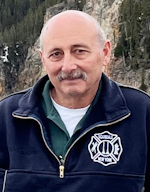
Jeffrey D. Gaskin
Jeffrey D. Gaskin is president of Big Red Trucks Fire Apparatus Consultants. He is a retired captain from the Scarsdale, NY, Fire Department. Throughout his career, Gaskin has been involved in apparatus acquisitions, from needs assessment through specification-writing. He also is a fire apparatus mechanic and holds certifications from Allison Transmission, Detroit Diesel, Hale Pump, Smart Power, Spartan Chassis, Sutphen Fire Apparatus and others. Gaskin is certified by the Emergency Vehicle Technician Certification Commission in six areas: Fire Apparatus Inspection, Maintenance and Testing (F-1); Design and Performance Standards of Fire Apparatus (F-2); Fire Pumps and Accessories (F-3); Aerial Fire Apparatus (F-5); Allison Automatic Transmission (F-6); and Hydraulic Systems (F-8). He can be reached at [email protected].
